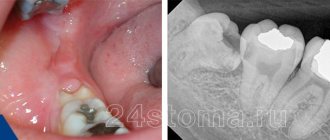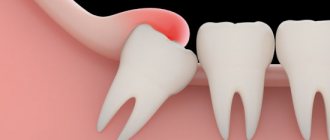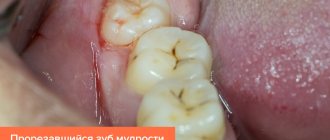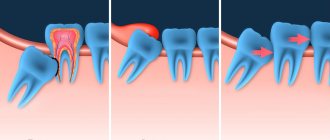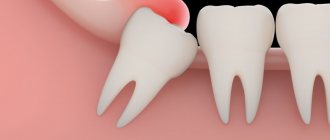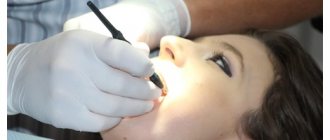For most people, the growth of wisdom teeth is accompanied not only by gum cutting and discomfort, but also by quite severe pain that makes it difficult to eat, concentrate on any task, and even sleep.
If the wisdom tooth grows and does not cause significant discomfort, no medical action may be taken. As a rule, the discomfort goes away after 1-2 weeks, but in order to avoid the manifestation of other problems, it is worth undergoing an examination at a dental clinic. However, if the gums from the wisdom tooth become inflamed, the local and general temperature rises, and specific aching pain is felt, immediately contact your dentist, he will conduct an examination and take the necessary measures to eliminate the problem.
Symptoms of wisdom tooth growth
During the period when a wisdom tooth comes in, a number of specific symptoms can be observed, by which it can be determined that the discomfort comes specifically from the eights:
- Discomfortable sensations in the tooth area, in some cases – gum thickening;
- Feeling of swelling in the gums;
- Increased local temperature, painful swelling;
- In the molar area, soft tissues (gums) become inflamed;
- Difficulty opening the mouth and swallowing. When opened wide, a sharp, aching pain is felt;
- There is a desire to chew any hard food or objects. After such chewing, the pain increases significantly;
- General increase in body temperature, general malaise and headaches.
Depending on the nature of growth, pain in wisdom teeth and specific symptoms can vary significantly. Regardless of how long a wisdom tooth grows - one or two weeks, it will cause certain sensations, and in case of complex or pathological growth - acute pain with inflammation of the gums.
An increase in general body temperature and swelling of the cheek indicates a severe course, as well as the possible development of pericoronitis - a complex disease of the oral cavity with a number of consequences.
How to understand that wisdom teeth are growing abnormally
Signs or symptoms that indicate problems include the following:
- numbness of the jaw and painful sensations - in this case we can say that the tooth is growing crookedly inside the bone and even injures the jaw nerve,
- sharp pain throughout the jaw, but more so near the base (where the temporomandibular joint is located),
- Above the figure eight, the gum is swollen, moves away from the surface, is red and very painful,
- the lymph nodes become inflamed and increase in size - this indicates the addition of an infectious process,
- the teeth in the row begin to shift - often this may not be noticeable to the person himself, but the doctor will see the changes after performing a panoramic x-ray,
- Due to the lack of space for quality hygiene, a carious cavity appears behind the wisdom teeth or gum disease begins to develop.
The main causes of pain
Painful symptoms from wisdom teeth are caused by the anatomical features of the upper and lower jaw, which are already fully formed in a person at the age of 17-25.
As the figure eight begins to grow, it puts pressure on neighboring teeth, bone and soft tissue. The growth process can last for months and even years, so pain manifestations are temporary, periodically fading and exacerbating.
The pain of tooth 8 can be provoked not only by its growth or anatomically incorrect position, but also by the presence of various pathologies, for example, caries, pulpitis, periodontitis or a wide range of infectious diseases. Note! The lack of timely professional help can provoke a worsening of the situation, which will result in the need to remove the diseased tooth and treat complications.
Myth #1: Wisdom teething causes crooked front teeth.
Wisdom teeth (third molars), along with the caudal vertebrae, auricular muscles, appendix and epicanthus, are rudiments, i.e. organs that have lost their basic significance in the process of human evolution.
Millions of years ago, our ancestors needed a massive dentofacial apparatus, consisting of a large number of teeth and capable of withstanding heavy loads. This was determined by the nature of nutrition, consumption of solid and tough food, its production, etc. In the process of evolution, there was an increase in the size of the cerebral part of the skull, a decrease in the shape and size of the jaws and teeth. Therefore, often when the last teeth erupt, there is not enough space in the dentition, as a result of which they erupt incorrectly, occupying a position outside the dental arch.
As the eighth teeth erupt, they put pressure on the ones in front, which subsequently leads to crowding of the anterior group of teeth. This is true, but only partly. In the process of erupting, wisdom teeth, of course, put pressure on the teeth in front, since often they simply do not have enough space in the dentition, but this pressure is not enough to cause crowding of the teeth.
It is important that the vector of eruption of the lower teeth is directed upward and slightly forward. Also, during growth, the lower jaw moves slightly upward, which can change the direction of teeth eruption. The incisors bend posteriorly, more than usual, and the molars erupt slightly anteriorly, which leads to a decrease in the length of the dental arch and does not allow the incisors to “straighten”.
It should be noted that crowding can also occur in people who lack third molar buds. Therefore, the main reason for the appearance of crowded teeth lies in the discrepancy between the size of the teeth and the size of the jaw, which is largely determined by a hereditary factor. Another reason may be the premature loss of primary teeth, which leads to improper eruption of permanent teeth and a decrease in space in the dental arch and subsequently to crowding of permanent teeth.
On the upper jaw, wisdom teeth can grow towards the cheek; this direction injures the mucous membrane and does not allow normal cleaning of this space with a toothbrush, which, in turn, contributes to the deposition of a large amount of plaque, which leads to dental caries. It is also possible to tilt towards the front tooth, which ultimately leads to the same consequences. In such cases, removal of wisdom teeth is required in order to prevent the increase in symptoms of inflammation in the oral cavity.
The rudiments of the eighth teeth are formed, unlike other teeth, after birth and erupt at the age of 18 to 25 years. It should be noted that some people simply do not have the rudiments of wisdom teeth, which, of course, in no way diminishes the level of their mental development, but once again confirms the theory of rudiments.
Tooth extraction is one of the most common operations in dental practice, the outcome of which depends on the correct and complete examination of the patient, at the stage of planning the surgical intervention, determining indications/contraindications, sequential implementation of all stages of tooth extraction and compliance with aseptic rules. It is important to remember the danger and frequency of complications in the postoperative period. Normally, healing of the hole occurs within 1-2 weeks. During this time, the hole is filled with granulation tissue, then osteoid tissue, and subsequently the formation of bone tissue occurs. For our patients, we use a special set of medications, which greatly facilitate the postoperative period and reduce the likelihood of complications.
Sincerely,
Dentist at the Golden Section Clinic
Alexey Anatolyevich Ivanov.
How to relieve pain if a wisdom tooth grows and your gums hurt.
The growth of wisdom teeth is not painless for every person, so most people need to know what to do in case of inflammation of the gums around the wisdom tooth and acute aching pain.
If there is inflammation, pain, or if the cheek is swollen near the wisdom tooth, you should contact your dentist, he will conduct an examination and take the necessary measures to eliminate symptomatic manifestations.
If the pain begins in the evening or it is not possible to quickly contact a specialized specialist, doctors recommend several ways to reduce pain:
- Rinse the growth with calendula tincture after eating - this will reduce the intensity of the inflammatory process and also reduce pain;
- Rinse your mouth with a solution of baking soda in water, at the rate of 1 teaspoon of soda per 1 glass of water (200 grams) - soda calms inflammation and also reduces pain;
- To rinse the mouth, you can use decoctions of chamomile, oak bark, chicory root, as well as sage tincture and propolis;
- Anti-inflammatory, painkillers and antibacterial drugs - use according to the instructions. They help reduce pain, reduce swelling, and also eliminate the negative bacterial influence at the site of tooth eruption.
In case of acute unbearable pain, as well as the absence of the above remedies, you can use cold water to reduce pain: take a glass of cool water, put a small amount in your mouth and hold it in the area where the wisdom tooth is erupting - this can quickly reduce the level of pain. However, this method has one negative feature - the pain intensifies almost immediately after stopping holding cool water at the site of gum inflammation, for example, near the hood of a wisdom tooth.
Possible complications during the development of wisdom teeth dystopia
Third molars are extremely problematic teeth. If teething occurs with tolerable pain and the patient does not rush to the dentist, then the following complications are possible:
- Pericoronitis – inflammation of the gum mucosa;
- A follicular cyst is a “sac” of fluid pressing on the roots;
- Periostitis is inflammation and suppuration (abscess) of the periosteum.
The appearance of these complications will lead to longer, more painful and expensive treatment, so you should not put off going to the doctor if you feel that your wisdom tooth has begun to erupt.
Where can I get dental care in Orenburg?
If your gums hurt where your wisdom teeth are, you can get qualified dental care in two places: public and private dental clinics. During the appointment, the dentist must:
- Conduct a preliminary examination of the oral cavity, determine the exact cause of the development of painful symptoms;
- If necessary, refer the patient for an x-ray - this procedure is often necessary in the presence of impacted wisdom teeth (completely or partially covered by gum), as well as in the case of surgical removal;
- Take the necessary measures to reduce or eliminate pain and swelling, as well as prevent further aggravation of the situation;
- If necessary, refer to a dental surgeon to remove third molars;
- Provide recommendations for further dental and oral care.
Do your gums hurt and you have symptoms of wisdom tooth growth? Seek qualified help from specialized specialists!
Extraction (removal) of wisdom teeth
Horizontal growth of the extreme molar is a situation where the only correct solution is often its removal. The intervention of a dental surgeon helps to avoid serious consequences caused by abnormal dental growth. The extraction itself goes like this:
- Anesthesia. Having determined the position of the tooth, the doctor selects the appropriate anesthesia: local in mild cases or general anesthesia if serious surgical intervention is necessary.
- Antiseptic treatment. The surgical field is prepared - the gums and teeth are treated with an antiseptic solution that will destroy all bacteria and microbes living in the oral cavity.
- Gum cutting. Using surgical instruments, a flap of soft tissue is carefully cut and peeled off from the neck of the tooth, root and bone. After the operation, the gum is returned to its place and fixed with sutures.
- Molar extraction. Using forceps and an elevator (a specially shaped wedge), the tooth is loosened and removed from the socket. If a piece of the root breaks off during removal, then an excavator (special medical hook) is used.
- Processing the hole. After removing the molar, the doctor examines the resulting hole and treats it with special drugs that prevent infection.
- Stitching. The cut gum is held together using medical materials, which after some time dissolve on their own, leaving behind fused soft tissue.
What to do if a wisdom tooth interferes with normal life
Modern dentistry initially suggests using painkillers, for example, Ibuprofen or Analgin, to relieve severe pain. Further, if it does not subside, you need to immediately contact a specialist. He will study the nature of the unpleasant sensations, evaluate the position of the “eight” and its role in the future (possibility of use for prosthetics). If it is unhealthy, then in 70-80% of cases the patient will be recommended to remove the wisdom tooth. This is due to difficult access to it. They also resort to its removal when it does not erupt for a long time and interferes with other molars.
A wisdom tooth causes a lot of trouble for its owner, and if you are faced with it, it’s time to visit an experienced dentist. Believe me, the problem will not be solved by itself! The specialists of the Kariesu.net clinic will quickly and reliably relieve you of pain and restore the joy of life.
Medication assistance at home
If the pain is very severe and folk remedies no longer give results, then you can take painkillers - Nurofen, Ketanov, Ketanol. The effect of taking the pill comes quickly, but does not last long (1-5 hours). There have been cases when painkillers do not help and a person takes an increased dose to get rid of pain, drinking a handful of tablets in a short time, which in turn can lead to serious consequences. In this case, it is recommended not to increase the dose, but to change the medicine to a similar one.
To reduce pain, oral and maxillofacial surgeons use the more expensive drug Ecoricoxib, which has a long-lasting analgesic and anti-inflammatory effect. The instructions for its use do not say anything about teeth, but it relieves pain from the eruption of wisdom teeth very well. It is enough to take one tablet per day.
To reduce pain, you can rinse your mouth with weak solutions of Eludride and chlorhexidine, which have an antiseptic effect. The Kamistal anti-inflammatory gel also helps; it contains chamomile and lidocaine hydrochloride, which relieves excruciating pain in the gums and bacterial activity under the hood.
This article is for informational purposes only, please consult your doctor for details!
